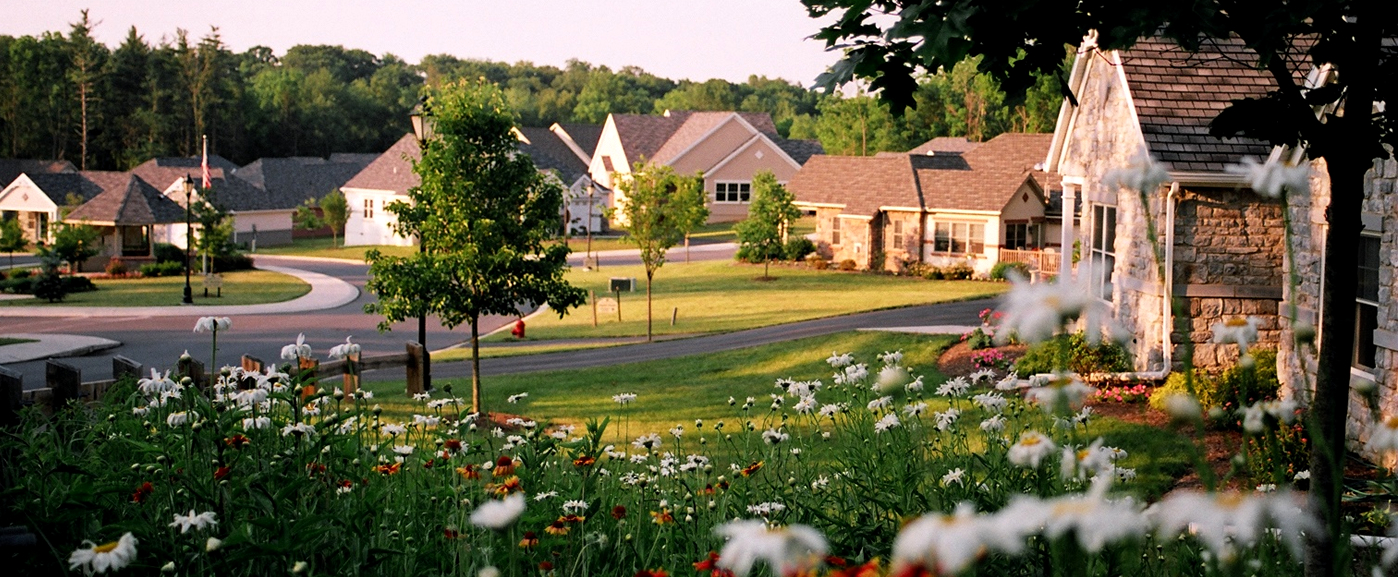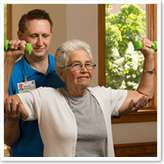Table of Contents
- What Is a Continuing Care Retirement Community?
- For-Profit vs. Not-For-Profit Retirement Communities
- Common Misconceptions About CCRCs
- Questions To Ask a CCRC
- CCRC Contract Types
- How Are Not-For-Profit CCRCs Financed?
- How To Choose the Right CCRC
If you are beginning to consider your retirement and your future, you are in good company. A recent Gallup poll suggests Americans are, on average, retiring at around 62 years of age, despite predictions that retirement age would actually be around 66 years. So whether retirement is on the horizon — or you have already retired — now is a great time to begin researching your options.
One of the most important questions you need to ask yourself is, “Where do I want to live?” What sort of needs, both anticipated and unanticipated, do you want to be prepared for in terms of your living situation? Should you downsize from your current living space? What role, if any, do you expect your family to play in your day-to-day needs? What are your health needs currently — and what health issues may you be facing in the future?
While you can’t predict the future, one way to address a variety of future needs is a continuing care retirement community (CCRC).
Learn More About Retiring at Cornwall Manor
What Are Continuing Care Retirement Communities?
Continuing care retirement communities (CCRCs) provide the opportunity to live in the same place as you get older, whatever quality-of-life needs you may have or develop. Many CCRCs offer levels of care with a variety of housing options, including apartments and houses — all on the same campus with many services and monthly maintenance included. Health care services, including physicians, home care, therapy, and wellness programs, personal care, and skilled nursing care are also normally located on-site for your use and convenience.
There are almost 2,000 CCRCs in the U.S., and beyond amenities offered, it is also important for you to consider the two main types of CCRC models — not-for-profit and for-profit. Each has its own set of considerations that can affect you in different ways. Understanding the differences between not-for-profit continuing care retirement communities and for-profit continuing care retirement communities will help you know who to trust with your future.
For-Profit vs. Not-For-Profit Retirement Communities
There are several main differences to consider between not-for-profit and for-profit CCRCs when beginning your research:
- Differences in quality: Which CCRC model will provide you with the highest quality of care?
- Differing levels of personal connection: Does one CCRC model value personal connection more than the other? What are the reasons for this?
The next sections will break down these differences to give you a closer look at why a not-for-profit continuing care retirement community like Cornwall Manor might be the best option for you.
For-Profit Senior Living Communities
Understanding the difference between a not-for-profit CCRC and a for-profit CCRC will help you immensely when making the choice about the path forward for you and consider your lifestyle options. The differences between the two CCRC models go beyond just collecting profits.
The major difference lies in why each type of facility does what it does and how the community is run. Characteristics unique to for-profit CCRCs include the following:
- Profit generation: A for-profit CCRC, like virtually all other for-profit entities, provides services with the end-goal of generating a profit.
- Responsibility to shareholders or investors: There are always expectations for returns on investment. All of those facilities ultimately answer to a board and investors. The unfortunate reality of a for-profit CCRC is that should a resident eventually have limited or depleted resources, they may be asked to relocate.
Not-For-Profit Retirement Communities
A not-for-profit CCRC invests its funds into the operations and improvement of the community. Your needs and wishes as a resident are what primarily drive organizational decisions. Leaders at these CCRCs are not answering to investors, stockholders, or other outside stakeholders.
One characteristic that’s unique to not-for-profit CCRCs is community support. Not-for-profit CCRCs engage in social accountability efforts by partnering with organizations in their community. Residents and staff members often work to improve the communities by volunteering and fundraising.
The Federal Centers for Medicare and Medicaid Services (CMS) provides annual ratings of retirement communities, and not-for-profit facilities consistently rank higher than many for-profit facilities.
Cornwall Manor is rated a 5-Star community, the highest rating, and its personal care program has received six deficiency-free annual inspections from the Pennsylvania Department of Human Services. Cornwall Manor maintains a beautiful campus while focusing on being a good steward of residents’ fees.
Personal Connection in a Not-For-Profit CCRC
Perhaps the most compelling reason older adults may choose a not-for-profit CCRC over a for-profit CCRC has to do with the former’s orientation toward meaningfully addressing senior needs. External economic pressure can affect the organizational values of for-profit CCRCs, and business needs are sometimes inherently at odds with resident needs. You want to find a place that can focus on you as much as possible.
The value of not-for-profit CCRCs falls under three major umbrellas:
- A chance for meaningful social experiences: Meaningful socialization helps residents connect with one another and build communal purpose and happiness. Not-for-profit CCRCs understand that just providing activities to keep residents engaged isn’t enough to make them happy. Residents have to be involved and engaged in lifelong learning, volunteering, and fulfilling endeavors in order to live a meaningful life.
- Investment of resources: Not-for-profit CCRCs are actually required by the law to reinvest their profits back into their organizations under section 501(c)(3) of the Internal Revenue Code in order to maintain their tax-free status.
- Social capital: By providing charitable care to older adults who may not have the funds to care for themselves, not-for-profit organizations encourage the community and older adults to help one another. A growing number of caregivers caring for the growing number of older adults who need assistance rely on not-for-profits to help them through their journey, which makes them more charitable in return.
Learn More About Retiring at Cornwall Manor
Common Misconceptions About CCRCs
Many people falsely believe that CCRCs are like retirement homes from years ago — meaning very institutional, highly medical, and lacking in privacy. This perception could not be further from the truth. Modern CCRCs, including Cornwall Manor, are dedicated to creating pleasant, livable environments tailored to the needs and wants of the older adults who live there.
Other misconceptions include the ideas that:
- Life in a CCRC is lonely, boring, and uneventful. In reality, there are a myriad of social activities and opportunities to make new friends and learn new things.
- Living in a CCRC is immensely more expensive than receiving the care and assistance you may need in your own home. In reality, you should be valuing the intangible benefits of living in a CCRC, including accessibility to a caring staff, the social aspect of living in a community among people with shared interests, and health care when you need it as soon as you need it. When you add up the costs for home maintenance, taxes, utilities, and other homeownership expenses, a CCRC can actually be comparable or even less expensive than remaining in your home.
- Living in a CCRC should be a last resort that only becomes a viable option once you become too sick to live on your own. If you wait too long to research your own CCRC, it could turn into a situation where the decision about where you live is made by someone other than you. Your future is your choice — don’t delay.
The fact is that most people who opt to live in a CCRC typically do not go on to regret their decision. One study, conducted by LCS, a firm tasked with developing, marketing, and managing senior living communities, found that feelings of stress, low confidence, and self-esteem, worry, and strain all declined within the first six months of moving into a CCRC. After a year, those who moved to a CCRC were happier and healthier than those who continued to live at home. These findings can help potential residents feel confident in their decision to move to a CCRC.
FAQs When Choosing on a Continuing Care Retirement Community
Before deciding which CCRC is right for you, there are a few major questions you should plan to ask. Cornwall Manor, a not-for-profit senior living community in the Central Pennsylvania area, provides quality housing and health care for older adults and maybe the right community for you. Below are the questions you should ask:
- What are the costs? Residents pay a one-time initial payment called an entrance fee which gives the resident their place to live as well as the contract for care and an ongoing monthly fee. Your monthly fee will cover various expenses, such as utilities, maintenance, transportation, security, housekeeping, emergency response system, property taxes, and fitness center use. Whether you can afford to live in a CCRC is an important consideration.
- Is the CCRC a not-for-profit or for-profit community? For-profit CCRCs are driven by their bottom line, while not-for-profit CCRCs are mission-driven. This can affect a CCRC’s objective.
- How is the CCRC doing financially? Ask to view financial records and check if there is anything unusual, like a significant amount of debt. If a CCRC refuses to provide you with audited statements, you may want to consider this a red flag.
- Is the entrance fee refundable? Ask whether your entrance fee will be refundable if you move and how much will be refundable.
- How long has the CCRC been operating? You may also want to inquire about how long the CCRC has been operating and what the occupancy rate is. The occupancy rate should be high unless the CCRC is a new development.
- What happens if my spouse needs a different level of care than I do? Most CCRCs can accommodate couples who require different levels of care but want to continue living together.
- What health care is available on-site? You may also want to ask if home health care is covered and what health services are available on-site.
- How will you help me maintain my independence and freedom? For example, you may want to ask about your dining service options and the flexibility of the dining program.
- How is resident satisfaction measured? Can I view your recent satisfaction surveys? You can get a good idea of the quality of a CCRC by looking at resident satisfaction levels. You may also want to ask how the CCRC uses the survey results.
- Can I review your CCRC’s residency agreement? Before making your decision, you should review the residency agreement, so you can fully understand the contract. Note any concerns or additional questions you have.
- What emergency response systems are available? The emergency response system will help you decide between CCRCs. Ask who will respond to an emergency. The CCRC you choose should also include 24-hour security.
- What are the most popular community programs? What kind of programs will be available to you? You’ll want to live in a community that offers programs that interest you.
- Who decides what events and programs to schedule? Rather than a staff member who decides on events and programs alone, resident-driven programming tends to rely on a committee to develop existing and new programs.
- What’s the difference between personal care and independent living? As states have different regulations, you may also want to ask what necessitates a change in your level of care.
Asking these questions of each CCRC you are considering will help you make this important decision about your life plan.
Learn More About Retiring at Cornwall Manor
Types of CCRC Contracts
As you consider your future in a continuing care retirement community, you need to be aware of the types of contracts that are available to you. CCRCs offer different contracts depending on your needs and the amount of care you may require. The different CCRC contracts are as follows:
- Type A: These contracts are also called “extensive life-care contracts.” They’re the most expensive of all CCRC contracts. The monthly fees are going to be higher but do cover all personal care, nursing, and medical treatment costs you might need throughout your time at the CCRC.
- Type B: Also referred to as “modified contracts,” Type B contracts are tailored to your current needs. This makes them more affordable than Type A contracts. Any additional needs will cost extra on top of your monthly payment as they arise.
- Type C: Think of these contracts as “fee-for-service contracts.” Your monthly payment will cover minimal services, making Type C contracts more affordable than other contracts. You will only be paying for the services you are using at the present time. If you do need a higher level of care, you would only be paying that when you need it.
- Type D: Some CCRCs offer Type D contracts, which are similar to standard rental contracts to cover housing without many additional health care services.
How Are Not-For-Profit CCRCs Financed?
It’s important to remember how not-for-profit CCRCs are financed when considering your options. Boards of investors limit the ways for-profit CCRCs are able to care for you during your stay. Not-for-profit CCRCs have much more freedom in giving you the care you need and deserve. Typically, CCRCs are financed through charitable giving, resident contracts and entry fees.
Charitable giving
Faith-based, not-for-profit CCRCs can be the recipients of generous donations from the community, fundraising organizations, and wealthy individuals. Many people in the community are passionate about older adult care, leading them to make donations to ensure the continuation of the not-for-profit CCRCs they care about.
Resident contracts
The monthly payments from residents are the main source of financial fluidity for not-for-profit CCRCs. These are what allow them to provide you continued care during your stay.
Entry fees
CCRCs require entry fees to help pay for continued care, even after some residents are no longer able to pay for their care. Entry fees can be costly, but they are essential in providing a financial foundation for CCRCs as the market changes and the cost of healthcare fluctuates.
Learn More About Retiring at Cornwall Manor
Choosing the Right Continuing Care Retirement Community
A CCRC should be just that — a community. Living in a community offers a whole host of benefits for older adults, including worry-free living and maintenance, socialization and entertainment, and assistance when and if you need it.
Cornwall Manor, located near Lancaster, Pennsylvania, offers independent living, personal care, and skilled nursing care – the entire continuum of care.
Independent living is just that…allowing individuals age 60+ the independence to enjoy their life while also having services and amenities to which they can enjoy. They then know that a higher level of care will be available to them when needed.
Personal care is a thoughtful combination of independence and personal attention to help residents through each day as their needs may change. This is particularly helpful for people who need additional personal care services they cannot receive at home.
Cornwall Manor also provides the following nursing care services in a new resident-focused health center:
- Short-term rehabilitation and physical therapy can assist older adults with regaining their motor functions and speech.
- Long term care for older adults who need assistance with bathing, dressing, and eating.
- Care for any wounds that need antibiotic administration, cleaning, and dressing changes.
- Skilled nursing care provided to any residents who have serious infections, injuries, or illnesses.
- Memory Support
You can expect that a not-for-profit continuing care retirement community like Cornwall Manor is committed to your care. It is our mission to help our residents lead a happier and healthier life. We live by the following values:
- Compassion
- Attitude
- Respect
- Excellence
- Service
Get Started With Cornwall Manor
At Cornwall Manor, we offer high-quality, diversified housing, health care, and other related services, so our residents can enjoy a fulfilling retirement and an aging lifestyle in a caring, secure, Christian environment.
The absolute best way to get a sense of the community and the life you can expect to lead is to visit our community, talk to other residents about their experiences and enjoy a meal in the community.
To learn more about this exceptional not-for-profit community, contact us at 717-274-8092 or at marketing@cornwallmanor.org for more information or to schedule your visit today.








